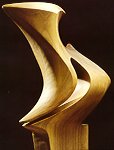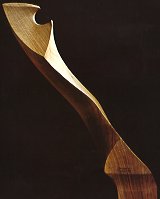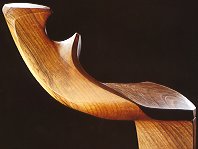OARS
AND OARLOCKS
Fórcole - the unmistakable
oarlocks used for Venetian rowing. They are made in
countless forms depending on whether they are used for
work, for recreation or for regattas. As well as the
consolidated traditional models, new forms are
continually being invented; certain models are abandoned
in favour of others considered to be more efficient (to
return later ‘in vogue’).
Fórcole are now considered objects of complex and
refined workmanship for which only the finest woods are used. They are kept and exhibited as precious
sculptures.
It should not be forgotten, however, that they are
derived from ‘poor ancestors’ - the fórcole
used for centuries every day by fishermen and boatsmen.
These early ancestors were generally flat, with large morsi
 , made with common - but tough - wood, often
leftovers from the construction of boats.
, made with common - but tough - wood, often
leftovers from the construction of boats.
Refined fórcole are characterized by the use of thick
blocks of wood to allow for sculpting, and to create the sanca
 - the ‘elbow’ which curves over the
outer side of the boat. In many cases the sanca
is a real necessity, in others it is an embellishment.
The same basic form is used as for the
‘working’ fórcole, but with a thickness which
allows the flat side to be completely rounded. The morsi
are reduced to the minimum necessary and therefore
twisted to allow the oar to pivot. They are carefully
finished with fine sandpaper and are often engraved and
finished with gold leaf.
- the ‘elbow’ which curves over the
outer side of the boat. In many cases the sanca
is a real necessity, in others it is an embellishment.
The same basic form is used as for the
‘working’ fórcole, but with a thickness which
allows the flat side to be completely rounded. The morsi
are reduced to the minimum necessary and therefore
twisted to allow the oar to pivot. They are carefully
finished with fine sandpaper and are often engraved and
finished with gold leaf.
Of these, the most impressive and famous - so much so
that examples are displayed as sculptures for their
striking visual impact - is that of the stern fórcola
for gondolas. It is between 85 and 90 cm high, with a sanca
of about 24 - 27 cm.
It can be divided into two main parts: the lower part,
the gamba  , which is inserted into a slot in the side of
the gondola and is normally hidden from view, and the
upper part used for the various manouevres of the oar.
Thes two parts are separated by a horizontal block called
the tapa
, which is inserted into a slot in the side of
the gondola and is normally hidden from view, and the
upper part used for the various manouevres of the oar.
Thes two parts are separated by a horizontal block called
the tapa  . The body of the fórcola extends outwards from
the tapa to form the elbow or sanca,
which has an almost triangular section with rounded edges. It bends back towards the boat until it is aligned
with the base, it flattening out to form the
‘head’ into which the morso is cut.
The pointed extremeties of the morso are called nasei
. The body of the fórcola extends outwards from
the tapa to form the elbow or sanca,
which has an almost triangular section with rounded edges. It bends back towards the boat until it is aligned
with the base, it flattening out to form the
‘head’ into which the morso is cut.
The pointed extremeties of the morso are called nasei
 , while the opposite protrusion récia
, while the opposite protrusion récia  .
.
 Stern fòrcola
for gondola
Stern fòrcola
for gondola
Bow fòrcola for gondola 
 Bow fòrcola, velàda
Bow fòrcola, velàda  , for gondola
, for gondola
Stern fòrcola for sàndolo 
 Stern fòrcola,
velàda, for sàndolo
Stern fòrcola,
velàda, for sàndolo
Stern fòrcola for gondolìn 
 Bow fòrcola for mascarèta
Bow fòrcola for mascarèta






